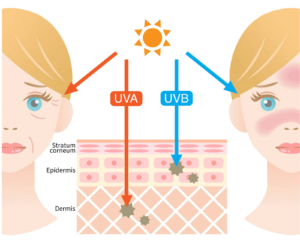With summer in full swing, it’s essential to understand the impact of ultraviolet (UV) rays on our skin. UV radiation is one of the most significant environmental factors that can damage our skin, leading to a host of issues from premature aging to skin cancer. Let’s delve into how UV rays affect your skin and what you can do to protect yourself.
What Are UV Rays?

UV rays are a form of electromagnetic radiation emitted by the sun. They are categorized into three types based on their wavelength:
- UVA Rays: These have the longest wavelength and can penetrate deep into the skin, affecting the dermis. UVA rays are primarily responsible for aging the skin, causing wrinkles and age spots.
- UVB Rays: These have a shorter wavelength and affect the outer layer of the skin, the epidermis. UVB rays are the main cause of sunburn and play a significant role in developing skin cancer.
- UVC Rays: These have the shortest wavelength and are absorbed by the Earth’s atmosphere, so they do not reach the surface. However, they can be dangerous when artificially produced, such as in tanning beds.
How UV Rays Damage the Skin

1. DNA Damage and Skin Cancer
UV radiation can directly damage the DNA in skin cells. This damage can lead to mutations, which, over time, can cause cells to grow uncontrollably, leading to skin cancer. Both UVA and UVB rays contribute to this risk, with UVB being the more potent carcinogen.
The Skin Cancer Foundation highlights that one in five Americans will develop skin cancer by age 70, underscoring the importance of UV protection.
2. Premature Aging
UVA rays penetrate deep into the skin and break down collagen and elastin fibers, which are crucial for maintaining skin’s firmness and elasticity. This process leads to wrinkles, fine lines, and sagging skin. Chronic exposure to UVA rays can result in a leathery texture and pigmentation changes, such as age spots.

The American Academy of Dermatology states that up to 90% of visible skin aging is caused by sun exposure.
3. Sunburn
UVB rays cause sunburn by damaging the DNA in the outermost layers of the skin. This damage triggers an inflammatory response, leading to redness, pain, and swelling. Repeated sunburns can significantly increase the risk of skin cancer.
According to the Centers for Disease Control and Prevention (CDC), sunburns can double your risk of developing melanoma, the deadliest form of skin cancer.
4. Hyperpigmentation and Uneven Skin Tone
UV exposure can lead to the overproduction of melanin, the pigment responsible for skin color. This can result in dark spots, freckles, and an uneven skin tone. Conditions like melasma, characterized by brown patches on the face, are also exacerbated by UV exposure.

The Mayo Clinic notes that UV radiation can increase melanin production, leading to hyperpigmentation issues.
5. Immune System Suppression
UV radiation can suppress the local immune response in the skin, making it less effective at identifying and repairing UV-induced damage. This suppression can contribute to the development and progression of skin cancer.
The World Health Organization (WHO) explains that UV exposure can lead to immune suppression, affecting the body’s ability to combat skin cancer.
Let your skin win this summer.
Understanding the impact of UV rays on your skin is the first step toward better skin health. By taking proactive measures to protect your skin from UV damage, you can enjoy the summer sun safely and maintain a youthful, radiant complexion. If you have any questions or need personalized advice on sun protection, don’t hesitate to reach out to our CULT Clinics office. We’re here to help you achieve and maintain beautiful, healthy skin!
Stay sun-safe and glowing,
